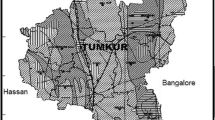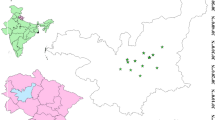Abstract
In this study, we present the results of measurements and radiological impact of natural radioactivity in soil and groundwater of the Himalayan region in the Uttarakhand State of India. The concentrations of primordial radionuclides (226Ra, 232Th and 40K) in soil samples of the study area were determined using gamma-ray spectrometry by employing the NaI(Tl) detector. The concentrations of radon and uranium were also measured in potable groundwater samples using RAD7 and Inductively Coupled Plasma Mass Spectrometry (ICPMS) techniques, respectively. The average specific activities of 226Ra (116 Bq kg−1), 232Th (137 Bq kg−1) and 40K (735 Bq kg−1) in soil were found considerably higher than the corresponding global average values. The average concentrations of radon (35 Bq l−1) and uranium (1.3 µg l−1) in potable groundwater were found well within the safe limits recommended by the World Health Organization. The effects of natural radioactivity in soil and groundwater are discussed in terms of different risk assessment parameters and dose quantities.








Similar content being viewed by others
References
UNSCEAR (1982) United nations scientific committee on the effects of atomic radiation. Exposures resulting from nuclear explosions, New York
UNSCEAR (2008) United nations scientific committee on the effects of atomic radiation. report to the general assembly, vol. 1, Annex. B. United Nations Publication, United Nations, New York
Karunakara N, Yashodhara I, Kumara KS, Tripathi RM, Menon SN, Kadam S, Chougaonkar MP (2014) Assessment of ambient gamma dose rate around a prospective uranium mining area of South India–a comparative study of dose by direct methods and soil radioactivity measurements. Results Phys 4:20–27
Nambi KSV, Bapat VN, David M, Sundaram VK, Sunta CM, Soman SD (1986) Natural background radiation and population dose distribution in India. Heal. Phys. Div. Bhabha At. Res. Centre, Bombay
Papadopoulos A, Christofides G, Koroneos A, Poli G (2013) Concentration of 238U and 232Th among constituent minerals of two igneous plutonic rocks exhibiting elevated natural radioactivity levels. J Radioanal Nucl Chem 298:639–650
Quindos LS, Fernandez PL, Soto J, Rodenas C, Gomez J (1994) Natural radioactivity in Spanish soils. Health Phys 66:194–200
Radhakrishna AP, Somashekarappa HM, Narayana Y, Siddappa K (1993) A new natural background radiation area on the southwest coast of India. Health Phys 65:390–395
UNSCEAR (2000) United Nations Scientific Committee on the Effects of Atomic Radiation. Sources and effects of ionizing radiation. Report to the General Assembly, Annexe B. United Nations Publication, United Nations, New York
Doyi IN, Essumang DK, Dampare SB, Duah D, Ahwireng AF (2017) Evaluation of radionuclides and decay simulation in a terrestrial environment for health risk assessment. Sci Rep 7:16537. https://doi.org/10.1038/s41598-017-16659-w
Przylibski TA, Gorecka J (2014) 222Rn activity concentration differences in groundwaters of three Variscan granitoid massifs in the Sudetes (NE Bohemian Massif, SW Poland). J Environ Radioact 134:43–53
Sharma DA, Rishi MS, Keesari T et al (2017) Distribution of uranium in groundwaters of Bathinda and Mansa districts of Punjab, India: inferences from an isotope hydrochemical study. J Radioanal Nucl Chem 313(3):625–633
Sharma DA, Keesari T, Rishi M et al (2019) Radiological and hydrological implications of dissolved radon in alluvial aquifers of western India. J Radioan Nucl Chem. https://doi.org/10.1007/s10967-019-06619-1
Keesari T, Mohokar HV, Sahoo BK et al (2014) Assessment of environmental radioactive elements in groundwater in parts of Nalgonda district, Andhra Pradesh, South India using scintillation detection methods. J Radioan Nucl Chem. 302:1391–1398
Aditya VS, Chidambaram S, Keesari T et al (2017) Occurrence of uranium in groundwater along the lithological contacts in central Tamilnadu. An Isotope Hydrogeochemical Perspective. Expo Health, India. https://doi.org/10.1007/s12403-017-0269-3
Todorovic N, Nikolov J, Forkapic S et al (2012) Public exposure to radon in drinking water in Serbia. Appl Radiat Isot 70:543–549
Ravikumar P, Somashekar RK (2014) Determination of the radiation dose due to radon ingestion and inhalation. Int J Environ Sci Technol 11:493–508
WHO (2009) WHO handbook on indoor radon: a public health perspective. World Health Organization, Geneva
Auvinen A, Salonen L, Pekkanen J, Pukkala E, Ilus T, Kurttio P (2005) Radon and other natural radionuclides in drinking water and risk of stomach cancer: a case-cohort study in Finland. Int J Cancer 114:109–113
Kurttio P, Salonen L, Ilus T, Pekkanen J, Pukkala E, Auvinen A (2006) Well water radioactivity and risk of cancers of the urinary organs. Environ Res 102:333–338
Prat O, Vercouter T, Ansoborlo E, Fichet P, Perret P, Kurttio P, Salonen L (2009) Uranium speciation in drinking water from drilled wells in southern Finland and its potential links to health effects. Environ Sci Technol 43:3941–3946
Zamora ML, Zielinski JM, Moodie GB, Falcomer RA, Hunt WC, Capello K (2009) Uranium in drinking water: renal effects of long-term ingestion by an aboriginal community. Arch Environ Occup Health 64:228–241
WHO (2011) Guidelines for drinking-water quality, 4th edn. World Health Organization, Geneva
AERB (2004) Drinking water specifications in India. Department of Atomic Energy, Govt. of India
Yadav M, Rawat M, Dangwal A, Prasad M, Gusain GS, Ramola RC (2014) Levels and effects of natural radionuclides in soil samples of Garhwal Himalaya. J Radioanal Nucl Chem 302:869–873
Ramola RC, Yadav M, Gusain GS (2014) Distribution of natural radionuclide along Main Central Thrust in Garhwal Himalaya. J Radiat Res Appl Sci 7:614–619
Yadav M, Rawat M, Dangwal A, Prasad M, Gusain GS, Ramola RC (2015) Analysis of natural radionuclides in soil samples of Purola area of Garhwal Himalaya, India. Rad Prot Dosim 167:215–218
Kandari T, Prasad M, Pant P, Semwal P, Bourai AA, Ramola RC (2018) Study of radon flux and natural radionuclides (226Ra, 232Th and 40K) in the Main Boundary Thrust region of Garhwal Himalaya. Acta Geophys 66:1243–1248
Prasad M, Kumar GA, Sahoo SK, Ramola RC (2018) Health risks associated with the exposure to uranium and heavy metals through potable groundwater in Uttarakhand state of India. J Radioan Nucl Chem. https://doi.org/10.1007/s10967-018-6281-70123456789
Prasad M, Kumar GA, Sahoo BK, Ramola RC (2018) A comprehensive study of radon levels and associated radiation doses in Himalayan groundwater. Acta Geophys 66:1223–1231
Heim A, Gansser A (1939) Central Himalaya: geological observations of the Swiss expedition 1936. Denkschriften der Schwieizerishen Naturforschenden Gasellschaft
Valdiya KS, Paul SK, Chandra T, Bhakuni SS, Upadhyay RC (1999) Tectonic and lithological characterization of Himadri (Great Himalaya) between Kali and Yamuna rivers, Central Himalaya. Him Geol 20:1–17
Manickavasagam RM, Jain AK, Singh S et al (1999) Metamorphic evolution of the northwest Himalaya, India: pressure temperature data, inverted metamorphism and exhumation in the Kashmir, Himachal and Garhwal Himalayas. Geol Soc Am Spec Pap 328:179–198
Choubey VM, Bartarya SK, Ramola RC (1999) Radon in Himalayan Springs: a geohydrological control. Environ Geol 39(6):523–530
Shanbhag AA, Sartandel SJ, Ramachandran TV, Puranik VD (2005) Natural radioactivity concentrations in Beach sands of Ratnagiri coast, Maharastra. J Assoc Environ Geochem 8:304–308
Ramola RC, Gusain GS, Badoni M, Prasad Y, Prasad G, Ramachandran TV (2008) 226Ra, 232Th and 40K contents in soil samples from Garhwal Himalaya, India and its radiological implications. J Radiol Prot 28:379–385
USEPA (2000) National primary drinking water regulations, radionuclides. United States Environmental Protection Agency, Washington, D.C.
HDR (2009) Human Development Report, National Resource Centre for urban poverty and All India institute of Local Self Government, Mumbai
Singh L, Kumar R, Kumar S, Bajwa BS, Singh S (2013) Health risk assessments due to uranium contamination of drinking water in Bathinda region, Punjab state, India. Radioprotection 48:191–202
Lee JS, Chon HT, Kim KW (2005) Human risk assessment of As, Cd, Cu and Zn in the abandoned metal mine site. Environ Geochem Health 27:185–191
Health Canada (1999) Uranium in drinking water. Document for public comment prepared by federal provincial subcommittee on drinking water
WHO (2004) Guidelines for drinking-water quality, vol 1, 3rd edn. World Health Organization, Geneva
US National Academy of Science, Institute of Medicine, Food and Nutrition Board (2004) Dietary reference intakes for water, potassium, sodium, chloride and sulphate. The National Academies Press, Washington
Bronzovic M, Marovic G (2005) Age-dependent dose assessment of 226Ra from bottled water intake. Health Phys 88:480–485
EC (1999) European Commission. Radiation protection 112, Radiological protection principles concerning the natural radioactivity of building material. Directorate–General Environment, Nuclear safety and civil protection
USEPA (2003) Current drinking water standards, Ground water and drinking water protection agency. United States Environmental Protection Agency, Washington, D.C.
Singh L, Kumar R, Kumar S et al (2013) Health risk assessments due to uranium contamination of drinking water in Bathinda region, Punjab state, India. Radioprotection 48(2):191–202
Rani A, Singh S, Duggal V et al (2013) Uranium estimation in drinking water samples from some areas of Punjab and Himachal Pradesh, India using ICP-MS. Radiat Prot Dosim 157(1):146–151
Patra AC, Mohapatra S, Sahoo SK et al (2013) Age- dependent dose and health risk due to intake of uranium in drinking water from Jaduguda, India. Radiat Prot Dosim 155(2):210–216
Rana BK, Dhumale MR, Lenka P et al (2015) A study of natural uranium content in groundwater around Tummalapalle uranium mining and processing facility, India. J Radioanal Nucl Chem 307(2):1499–1506
Yadav AK, Sahoo SK, Mahapatra S et al (2014) Concentrations of uranium in drinking water and cumulative, age-dependent radiation doses in four districts of Uttar Pradesh, India. Toxicol Environ. Chem 96(2):192–200
Jakhu R, Mehra R, Mittal HM (2016) Exposure assessment of natural uranium from drinking water. Environ Sci Process Impacts 18(12):1540–1549
Duggal V, Sharma S (2017) Chemotoxicity and radiotoxicity risk assessment from exposure to uranium in groundwater from Western Haryana, India. Int J Pure Appl Phys 13(1):107–112
Virk HS, Jakhu R, Bangotra P (2016) Natural uranium content in ground waters of Mohali and Fatehgarh Districts of North Punjab (India) for the assessment of excess cancer risk. Glob J Hum Soc Sci B 16:13–17
Kumar A, Kaur M, Sharma S et al (2016) A study of radon concentration in drinking water samples of Amritsar city of Punjab (India). Radiat Prot Environ 39:13–19
Mittal S, Rani A, Mehra R (2016) Radon levels in drinking water and soil samples of Jodhpur and Nagaur districts of Rajasthan, India. Appl Radiat Isot 113:53–59
Kumar M, Kaushal A, Sahoo SK et al (2017) Measurement of uranium and radon concentration in drinking water samples and assessment of ingestion dose to local population in Jalandhar district of Punjab, India. Indoor Built Environ 28(5):611–618
Duggal V, Sharma S, Mehra R (2017) Radon levels in drinking water of Fatehabad district of Haryana, India. Appl Radiat Isot 123:36–40
Prasad Y, Prasad G, Choubey VM et al (2009) Geohydrological control on radon availability in groundwater. Radiat Meas 44:122–126
Acknowledgements
Science and Engineering Research Board, Department of Science and Technology, Government of India is thankfully acknowledged for providing financial assistance in the form of National Post Doctoral Fellowship (File No: PDF/2016/000565).
Author information
Authors and Affiliations
Corresponding author
Additional information
Publisher's Note
Springer Nature remains neutral with regard to jurisdictional claims in published maps and institutional affiliations.
Rights and permissions
About this article
Cite this article
Prasad, M., Ranga, V., Kumar, G.A. et al. Radiological impact assessment of soil and groundwater of Himalayan regions in Uttarakhand, India. J Radioanal Nucl Chem 323, 1269–1282 (2020). https://doi.org/10.1007/s10967-019-06827-9
Received:
Published:
Issue Date:
DOI: https://doi.org/10.1007/s10967-019-06827-9




